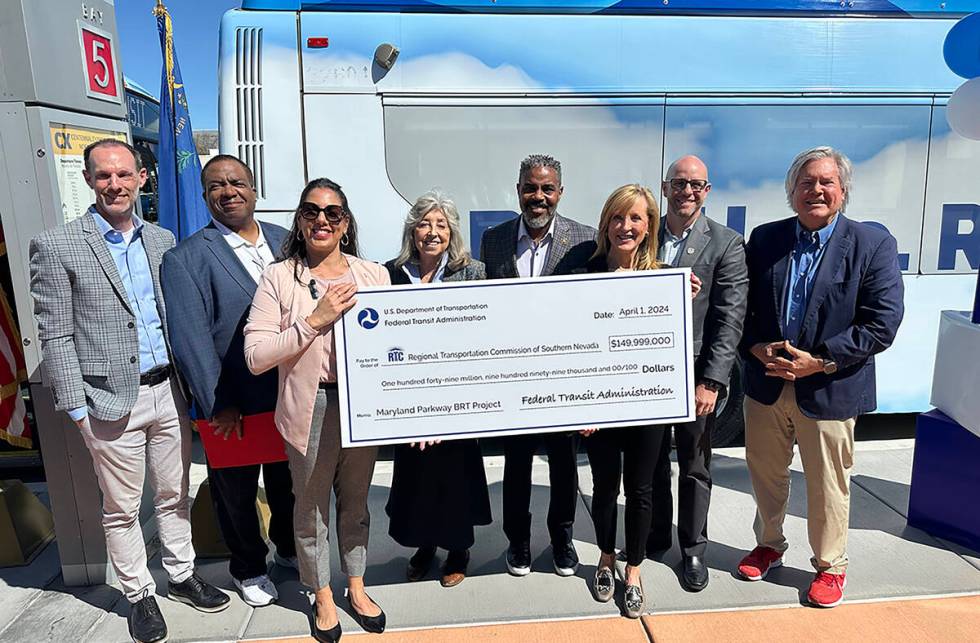Maryland Parkway bus rapid transit project gets a big boost

A $150 million federal grant announced Monday will help kickstart construction of a long-planned bus rapid transit line along Maryland Parkway into downtown Las Vegas.
The $378 million rapid transit line will run along a 12.5-mile corridor on Maryland Parkway from Harry Reid International Airport to downtown Las Vegas and the Las Vegas Medical District.
“The Maryland Parkway BRT will make a real difference for those living and working in Las Vegas,” Federal Transportation Administration Acting Administrator Veronica Vanterpool said at a ceremony to award the money to the Regional Transportation Commission of Southern Nevada.
“This system is not the transportation system from the past. This is the transportation system of the future,” she said during the Monday morning event at UNLV.
Construction is expected to kick off this summer and wrap up in 2026, officials said. The RTC has been working to secure the federal grant award for several years.
“It’s a lot of hard work. It’s a lot of financial scrubbing. It’s a lot of planning,” RTC CEO MJ Maynard said. “It’s a big deal, and it will help us ensure this project is successful.”
The Maryland Parkway corridor, home to 90,000 residents, provides 80,000 jobs, with the current bus service seeing about 9,000 transit riders daily. The RTC previously estimated that ridership on the route under the BRT project would increase to 13,300 daily passengers in the opening year.
Enhancements coming
The project includes enhanced transit shelters, shared bus-bike lanes, wider sidewalks, and improved lighting and landscaping.
Plans call for 7.2 miles of dedicated bus lanes on the Maryland Parkway route, where buses will receive traffic signal priority. The RTC estimates the new BRT service will cut travel time for riders by about 20 percent compared with the travel time for the current traditional bus route. Stations on the Maryland Parkway BRT will be spaced a third of a mile apart.
“One of the best validations of these investments is when you see buses whiz through on dedicated bus lanes,” Vanterpool said. “Bus riders deserve that reliability and they deserve that time savings as well.”
Each bus on Maryland Parkway will be 60 feet long and have capacity to carry 90 passengers per vehicle. All 15 buses used on the route will be hydrogen fuel cell-powered, a first in the valley.
The bus rapid transit option was chosen in 2019 by the RTC board of commissioners, over a proposed $1 billion light rail option and a cheaper $29 million upgrade of the current Route 109 in place.
‘Win-win in a lot of ways’
Part of the project includes moving above-ground power lines along Maryland Parkway near UNLV underground, to make the stretch more aesthetically pleasing. Clark County Commission Chairman Tick Segerblom has envisioned the move for several years and said he hopes it leads to new development along the stretch.
“The look will be much, much better,” Segerblom said. “It’s a win-win in a lot of ways.”
UNLV President Keith Whitfield said grounding the power lines will open up development possibilities on the east side of Maryland Parkway.
“It is very big in the long run because our desire to be able to build on the eastern side (of Maryland Parkway), it’s got to be something that’s attractive,” Whitfield said. “It’s the idea that you’re going to have some place that’s functional, but attractive.
“That’s what’s going to drive people to this part of the city,” Whitfield said. “In some ways that’s what UNLV wants to do — our piece of being the University District.”
Contact Mick Akers at makers@reviewjournal.com or 702-387-2920. Follow @mickakers on X.